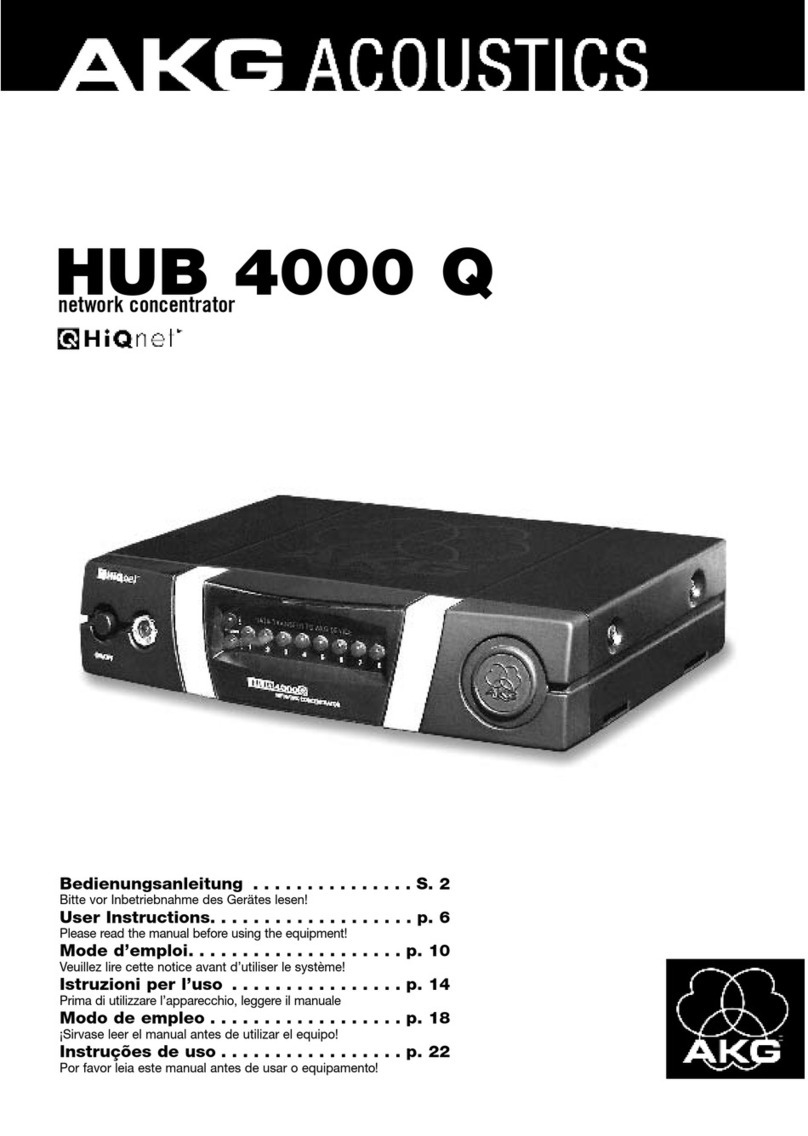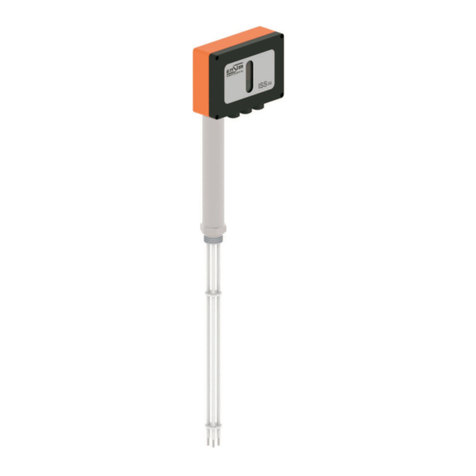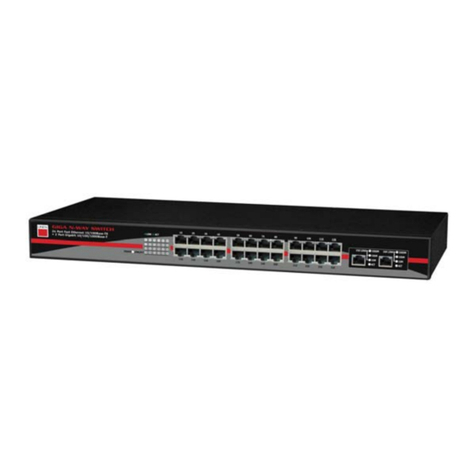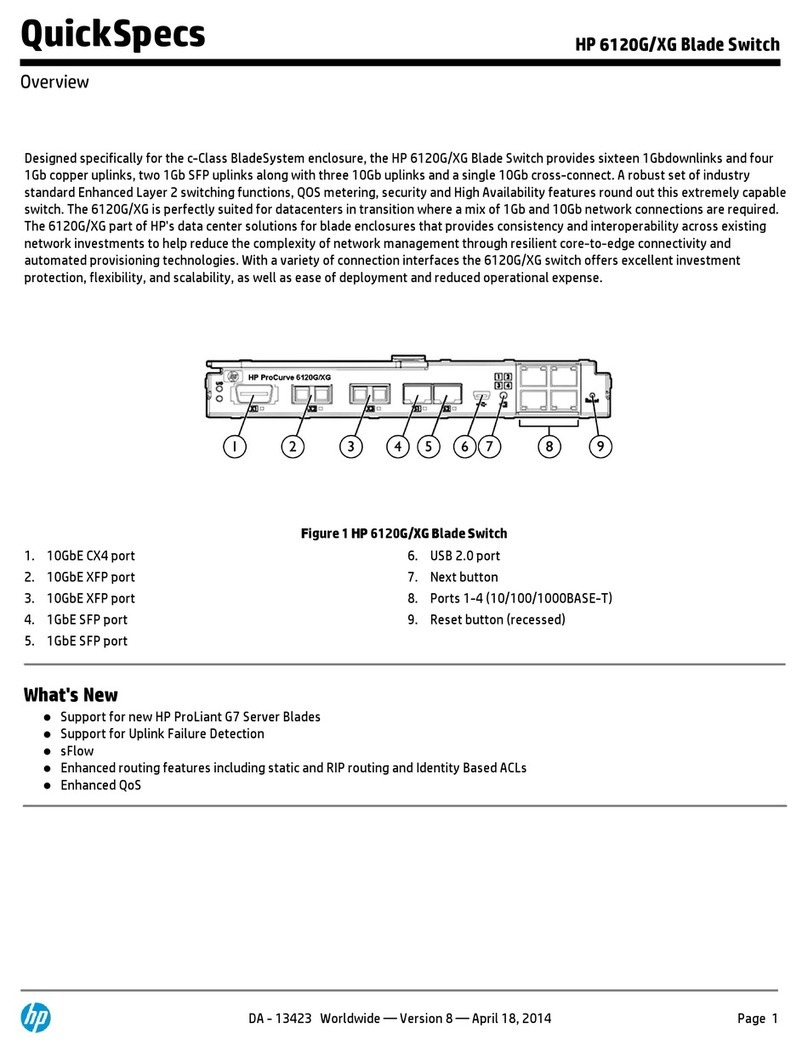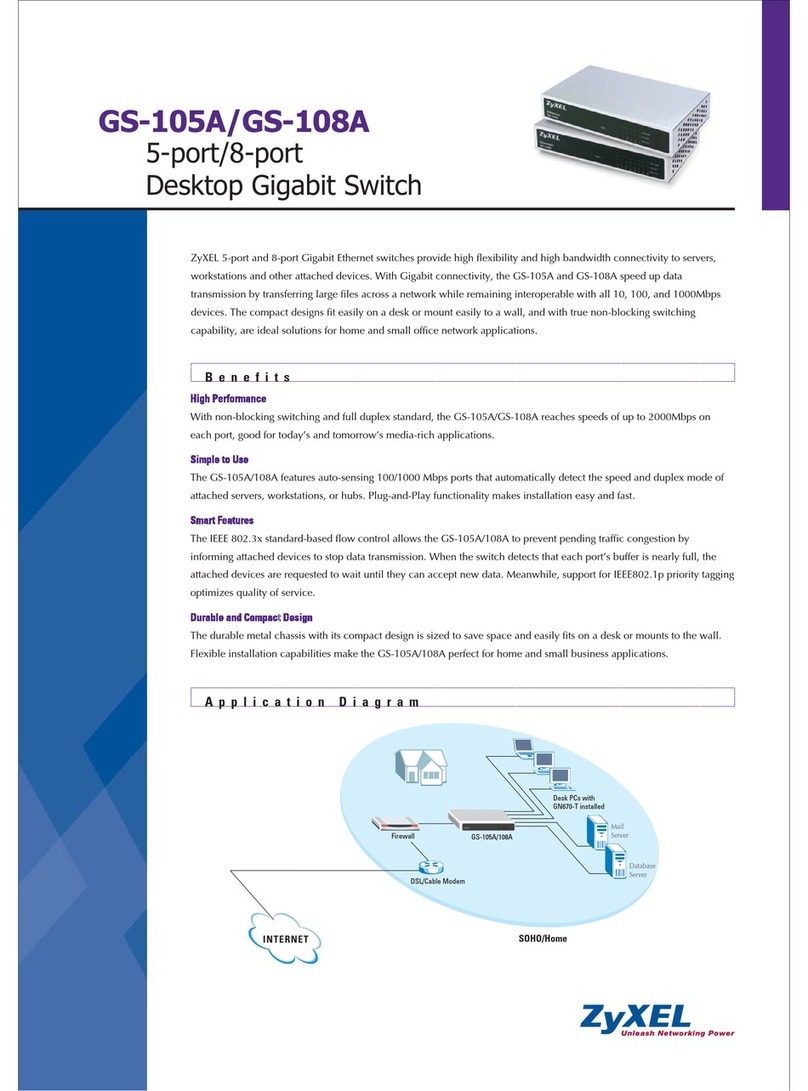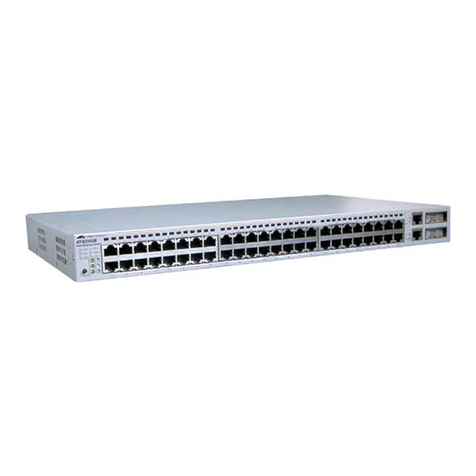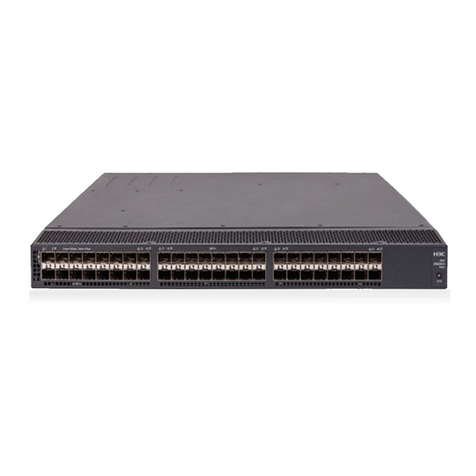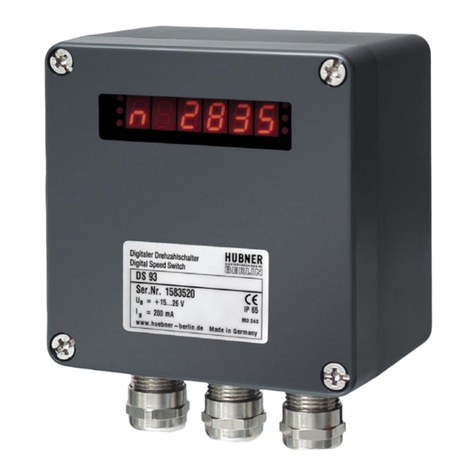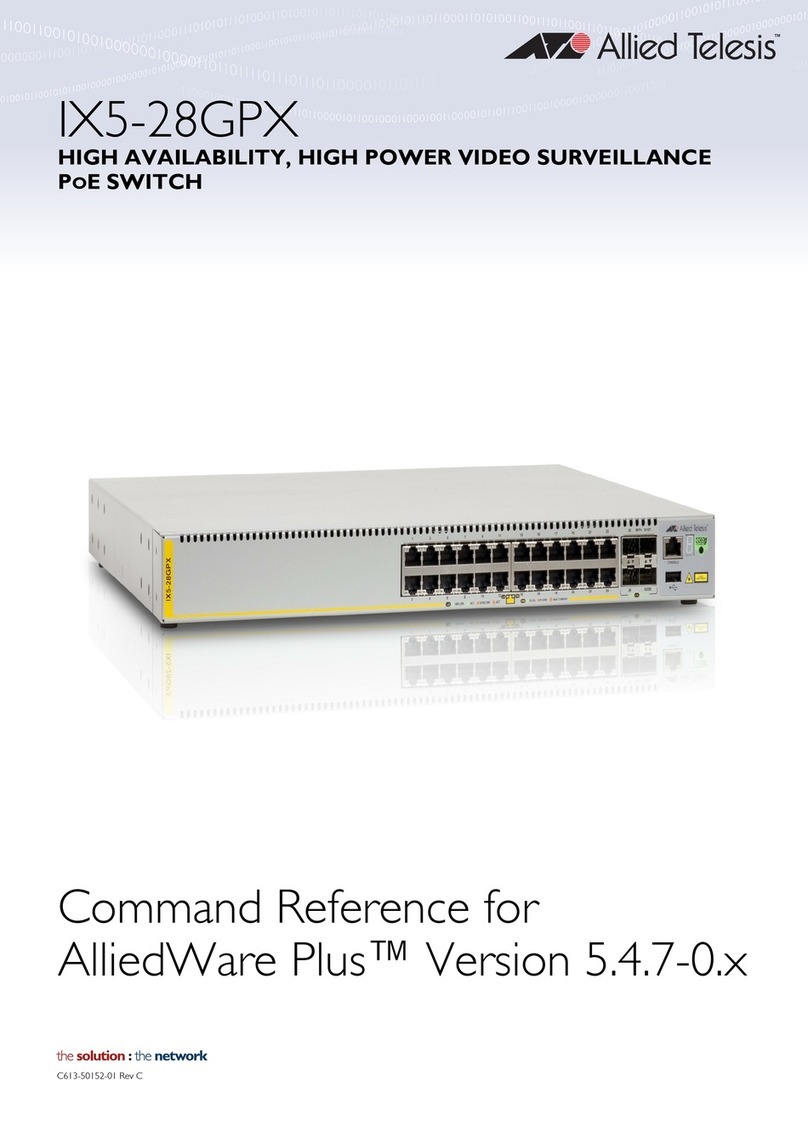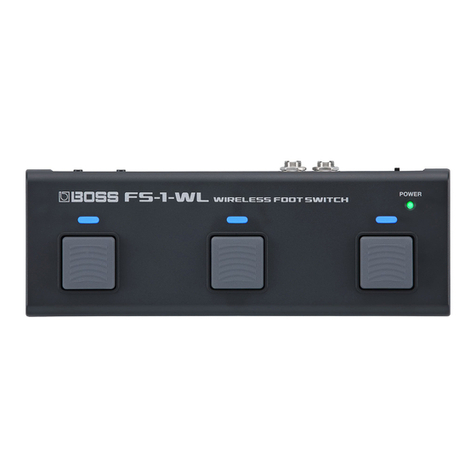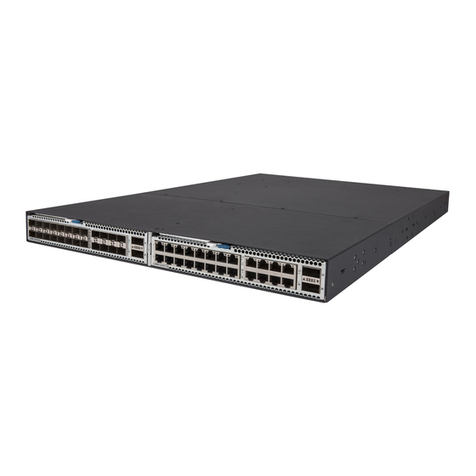Ahlborn ALMEMO 4490-2 User manual

Operating Instructions
Switchboard Instrument
ALMEMO®4490-2
V1.2
04.12.2003
ALMEMO4490-2 1

Operating Instructions
Switchboard Instrument
ALMEMO®4490-2
For Reference with the ALMEMO®Manual
Table of Contents
Page
1. INTRODUCTION 4
1.1 Function Range 4
1.2 Front Operating Controls 9
1.3 Rear Operating Controls 10
2. INITIAL OPERATION 11
3. POWER SUPPLY 11
3.1 Mains Operation 11
3.2 DC Voltage Supply 11
3.3 Data Storage, Reinitialisation 11
4. CONNECTION OF THE TRANSDUCERS 12
4.1 Transducers 12
4.2 Measuring Inputs and Additional Channels 13
5. DISPLAY AND KEYPAD 14
5.1 Display 14
5.2 Selection and Activation of Functions 15
5.3 Keypad 16
5.4 Data Input 16
2 ALMEMO4490-2
Table of Contents

6. SENSOR PROGRAMMING 17
6.1 Selecting the Measuring Channel 17
6.2 Selecting the Measuring Range 17
6.3 Changing the Dimension 20
6.4 Limit Values 21
6.5 Correction Values 22
6.6 Scaling, Decimal Point Setting 23
6.7 Locking of the Sensor Programming 24
7. MEASUREMENT 25
7.1 Continuous Measurement of a Measuring Point 25
7.1.1 Selecting the Measured Value and Measuring Point 25
7.1.2 Conversion Rate, Continuous Measuring Point Scan 26
7.1.3 Memory for Peak Values 26
7.1.4 Setting Measured Values to Zero, Zero Point Correction 27
7.1.5 Atmospheric Pressure Compensation 29
7.1.6 Temperature Compensation 29
7.2 Measuring Point Scans 30
8. ANALOGUE OUTPUT 30
8.1 Scaling 31
9. DIGITAL DATA OUTPUT 31
9.1 Baud Rate, Data Format 31
9.2 Device Address and Networking 32
9.3 Manual Data Output 33
10. TROUBLESHOOTING 34
11. ELECTROMAGNETIC COMPATIBILITY 35
APPENDIX 36
Technical Data 36
Product Overview 36
ALMEMO4490-2 3
Table of Contents

1. INTRODUCTION
The switchboard instruments ALMEMO®4490-2
Version 5
are instruments
from the unique product range of measuring devices that are all equipped with
the ALMEMO®connector system, which has been patented by Ahlborn GmbH.
The intelligent ALMEMO®connector provides important advantages with
regard to the connection of sensors and peripherals as all parameters are
stored in an EEPROM within the connector. As a result, the programming that
usually has to be performed for the connection is not required.
All sensors and output modules can be connected to all ALMEMO®instruments
in the same way. The operation and programming is identical with all units.
Therefore, all ALMEMO®measuring system items listed below are described,
in detail, in a separate ALMEMO®manual that is supplied with every device:
Detailed description of the ALMEMO®system (manual section 1)
Overview of the device functions and measuring ranges (manual section 2)
All sensors with basic principles, operation, technical data (man. section 3)
The options for connecting existing sensors (manual section 4)
All analogue and digital output modules (manual section 5.1)
The interface module RS232, fiber optics, Centronics (manual section 5.2)
The entire ALMEMO®networking system (manual section 5.3)
All functions and their control via the interface (manual section 6)
A complete interface command list with all print outputs (manual section 7)
These operating instructions only cover features and controls that are specific
for a certain device. As a result, the sections dealing with the system control
via keypad will only often provide a note referring to a more detailed description
within the manual (manual section x.x.x).
1.1 Function Range
The switchboard instrument ALMEMO®4490-2 has an ALMEMO®measuring
input with 4 channels or a measuring channel for a direct connection of
sensors. Two output sockets allow for connecting any ALMEMO®output
modules, for example, the analogue output, digital interface, trigger input or
alarm contacts. As an option, an electrically isolated analogue output and
relays can also be integrated into the instrument. Several devices can be
networked by simply connecting them with network cables.
For an easy operation a keypad and a 6-digit LED display are integrated. The
instruments have many functions for an optimal evaluation of all sensors. To
avoid a difficult operation resulting from functions that are not required, the
functions can be activated and deactivated automatically or by selecting the
display mode or individually via the interface. A range of special functions can
only be accessed via the interface.
4 ALMEMO4490-2
Functions

SENSOR PROGRAMMING
The measuring channels are automatically programmed by the ALMEMO®
connectors of the sensors. However, the user can easily complete or modify
the programming via keypad or interface.
Measuring Ranges
There are corresponding measuring ranges for sensors with a non-linear
characteristic such as 10 thermocouple types, Ntc and Pt100 sensors, infrared
sensors, and flow sensors (rotating vanes, thermoanemometers, pitot tubes).
Humidity sensors are available with additional function channels that also
calculate humidity data such as dew point, mixture ratio, vapour pressure and
enthalpy. Even complex chemical sensors can be used. The acquisition of
measured data from other sensors is easily possible by using voltage, current
and resistance ranges with individual scaling in the connector. Existing sensors
can be used without problems. Only the corresponding ALMEMO®connector
has to be connected using its terminals. Furthermore, there are adapter
connectors with an own microcontroller for digital signals and for measuring
frequencies and pulses. This way, nearly all sensors can be connected to any
ALMEMO®measuring instrument and are interchangeable without requiring
any settings.
Function Channels
Maximum, minimum, average values and differences of two measuring
channels can be programmed as function channels and can be processed and
printed like normal measuring points.
Dimension
The 2-digit dimension can be altered for each measuring channel so that the
display and the printout will always indicate the correct dimension, for example
when a transmitter is connected. The conversion from °C to °F is automatically
performed according to the dimension.
Name of Measured Values
Sensors can be identified by a 10-digit alphanumeric designation. It is entered
via the interface and appears on the printout or display if the evaluation is done
via PC.
Correction of Measured Values
For correcting measured values a zero point and slope (gain) correction can be
applied to the measured value of each measuring channel. This also allows for
sensors to be interchanged that usually, at first, require an adjustment
(expansion, force, pH). The zero point and the slope (gain) correction can be
performed by the push of a button.
ALMEMO4490-2 5
Functions

Scaling
The base value and the factor allow for a further scaling of the corrected
measured value of each measuring channel for zero point and slope (gain).
The decimal point position can be set by the exponent.
Limit Values and Alarm
Two limit values (optionally Max and/or Min) can be set for each measuring
channel. An alarm value printout can be performed if a limit value is exceeded
and, by means of the limit value relay option, alarm contacts are available that
can be individually allocated to limit values. As a standard, the hysteresis is set
to 10 digits, however, it can also be set between 0 and 99 digits. Furthermore,
limit value exceeding can also be used to start or stop a measuring point scan.
Sensor Locking
All sensor data stored in the EEPROM of the connector can be protected
against undesired access by means of a graded locking function.
MEASUREMENT
A total of up to 4 measuring channels are available for each transducer, i.e. it is
also possible to evaluate double sensors, individually scaled sensors, or
sensors with function channels. The measuring channels can be successively
selected forwards or backwards via keypad. The selected measuring point can
be scanned with a conversion rate of 2.5 or 10 measurements/second. The
measured value is calculated and indicated on the display or, if available,
provided on the analogue output. Standard sensors without an ALMEMO®
connector can be directly connected by means of a special multipoint
connector. The programming of the corresponding channel must be performed
each time the sensor is changed.
Measured Value
A continuous presentation of measuring data from the selected measuring
point is provided and also includes automatic zero point correction and optional
correction of the measured value or new scaling.
A sensor breakage condition is, with most sensors, automatically detected
(exception: connectors with shunts, dividers or additional electronics).
Measuring Functions
Special measuring functions are required for some sensors in order to achieve
an optimal acquisition of measuring data. The cold junction compensation is
available for thermocouples, a temperature compensation for dynamic
pressure and pH and conductivity probes, and an atmospheric air pressure
compensation for humidity sensors, dynamic pressure sensors and O2
sensors. With infrared sensors the parameters zero point and slope correction
are used for background temperature and emissivity factor.
6 ALMEMO4490-2
Functions

Analogue Output and Scaling
By means of analogue start and analogue end the indicated measured value
can be scaled so that the resulting measuring range covers the full analogue
output range (0-2V, 0-10V or 0/4-20mA).
Max and Min Value
Each measurement involves an acquisition and storing of the maximum and
minimum value. These values can be displayed, printed and cleared.
PROCESS FLOW PROGRAMMING
A cyclic measuring point scan with a time-based process flow control is
required to register measuring data of all measuring channels via the interface.
For this purpose, a clock, the print cycle and the measuring cycle are available
and, if fast processing is required, the conversion rate is available. The
measurement can be started and stopped by using the interface, an external
trigger signal or an exceeding of limit values.
Time and Date
Time and date or the pure measuring time is used for the recording of any
measurement.
Print Cycle
The print cycle is programmable between 1s and 59h/59min/59s. It allows a
cyclic output of measured values to the interfaces as well as a cyclic averaging.
Measuring Cycle
The measuring cycle, also programmable between 1s and 59h/59min/59s, is
for a cyclic scanning with limit value monitoring, alarm message and output of
alarm values and averaging.
Average Value over Measuring Point Scans
The measured values that result from measuring point scans can be averaged
as desired either over the total measuring time or over the print cycle. Function
channels are provided for a cyclic output of average values.
Conversion Rate
With ALMEMO®
V5
devices, all measuring points can be continuously
scanned with the conversion rate (2.5 or 10 meas./s). It is also possible to
provide all measured values as an output via the interface.
Control Outputs
The interface allows to individually trigger the 2 internal or up to 4 external
output relays and one analogue output.
ALMEMO4490-2 7
Functions

Output
All measuring and programming data is, firstly, accessible via keypad and LED
display. RS232, RS422 and a Centronics interface are available by using
different interface cables. All data logs, stored measured values and
programmed parameters can be provided as output to any peripheral
equipment. The output of measuring data can be selected in list format,
columns or spreadsheet format. Files in spreadsheet format can be processed
by each spreadsheet software. The print header can be programmed
specifically to the company or application.
Networking
All ALMEMO®devices can be addressed and can be easily networked by a
simple connection with network cables or network junctions for longer
distances.
Software
The AMR-Control software, which allows for the entire programming of the
sensors and the configuration of the measuring instrument, is supplied with
each ALMEMO®manual. The integrated terminal also allows for online
measurements. The WINDOWS®software packages, Win-Control and
DATA-Control, are available for data acquisition of networked devices,
graphical presentation and complex data processing.
8 ALMEMO4490-2
Functions

1.2 Front Operating Controls
(1) LED DISPLAY 4-digit 7-segment and minus f. meas. and progr. values
2-digit 14-segment for dimension or function
(2) MEAS. CHAN. M1, M2, M3 (M0 clamp. conn. or ALMEMO®without display)
(3) ALARM LAMPS A1 and A2 for limit value 1 and limit value 2
(4) FUNCTION KEYS
ENTER, ▲▼, entering programming values
▲
ENTER, CLR clear data, set measured value to zero
MEAS.VAL. ▲ selection of meas. value and meas. point
F1 selection of measuring functions
max value (Hi) MH
min value (Lo) ML
conversion rate CR
~for humidity, dyn. press. a. O2sensors atmospheric pressure mb ~
" for pH and dyn. pressure probes temperature compensation TC "
F2 selection of programming functions
range R
limit value 1 max/min (Hi/Lo) H1/L1
limit value 2 min/max (Lo/Hi) L2/H2
hysteresis HY
base value BA
factor FA
exponent EX
zero point correction ZC
slope (gain) correction SC
^ for IR sensors ambient temperature AT ^
emissivity factor EF ^
locking mode LM
* with interface module baud rate BR *
device address A*
analogue output - start AS
analogue output - end AE
analogue output type 0/4-20 mA
ALMEMO4490-2 9
Operating Controls

1.4 Rear Operating Controls
(5) Power Supply N-L 230 V AC, 50/60 Hz
Option U -+ 10..36 V DC
(6) Relay Contacts S1-C1-Ö1 lim. value 1 (make and break)
S2-C2-Ö2 lim. value 2 (make and break)
(7) Analogue Output Out -+ electrically isolated
Option R1 -1.25 V to 2 V (0.1mV/digit)
Option R2 -6.00 V to 10 V (0.5mV/digit)
Option R3 0/4 mA to 20mA (1µA/digit)
Meas. Inputs
(8) Clamp. Connector A-B-C-D meas. chan. M0, internal for exist. sensors
Sensor Volt. Supply -+ ca. 7V DC, 50 mA not electrically isolated
Option V1 12V DC, 30 mA electrically isolated
Option V2 12V AC, 50 mA electrically isolated
(9) ALMEMO®socket M meas. chan. M0 to M3 for all ALMEMO®sensors
Output Sockets
(10) ALMEMO®socket A2 network cable ZA1999-NK5
trigger input with cable ZA 1000-ET
relay outputs ZA 1000-EGK
analogue output 2 ZA 1601-RK
(11) ALMEMO®socket A1 V24 interface with cable ZA 1909-DK5
V24 interface with fiber optics ZA1909-DKL
RS 422 (ZA 5099-NVB / L)
analogue output 1 with cable ZA 1601-RK
AHLBORN
C1 C2S2S1 O1 O2
ABCD
OUT
20mA
-+-+
M1
AMR
NL
230V~
A1A2
5
6
78
91011
10 ALMEMO4490-2
Operating Controls

2. INITIAL OPERATION
1. For power supply, depending on the version (see type plate), connect
mains supply 230 V AC or 10-36 V DC to terminals (5), see 3.1 and 3.2.
2. Connect transducer with ALMEMO®connector to socket M1 or
connect a sensor with bare ends to the clamping connector (8),see 4.2.
Program the measuring range in function ´ R´ (F2), see 6.2.
3. Displaying the measured values
Select function MEAS. VALUE and meas. channel
with key MEAS.VAL.▲(4), read measured value, see 7.1.
4. Limit value monitoring
Enter limit values using key F2 in function ´H1´ or ´L2´, see 6.4.
Connect alarm device to clamping connector (6).
5. Display max and min values using key F1 in function ´MH´ or ´ML´, s. 7.1.3.
6. Data transfer to a computer
Connect peripheral device via interface cable to socket A1, see man. 5.2.
Set 9600 bd, 8 data bits, 1 stop bit, no parity, at peripheral device, see 9.1.
Enter commands by using the terminal of AMR-Control, see man. 6.
3. POWER SUPPLY
Before connecting any supply voltage refer to the type plate to
ensure the correct type of power supply!
3.1 Mains Operation
For mains operation the power supply 230V +-10% / 50-60Hz must be
established via the terminal screw connector at socket (5) on the rear side of
the unit.
Please note that connection to the 230V mains supply network
must only be performed by a qualified electrician.
3.2 DC Voltage Supply
The option U is required for a 10...36 V DC voltage supply with an electrical
isolation. The voltage must be connected via a terminal screw connector to
socket (5) on the rear side of the unit.
3.3 Data Storage, Reinitialisation
The measured data, time and date will be lost when the device is switched off.
However, all programmed values and the calibration in the EEPROMs will be
maintained.
ALMEMO4490-2 11
Initial Operation

If the device is not functioning properly due to disturbances (e.g. electrostatic
charging) or if incorrect programming must be avoided, the instrument can be
reinitialised.
The reset can be achieved if the key CLR is pressed during switch-on. During
this process the measuring data, time and date, as well as all internal data
such as cycles, conversion rate, atmospheric pressure and function key
assignment, will be cleared or set to their default values. However, the device
configuration and the sensor programming within the ALMEMO®connectors
will not be affected by the reset.
4. CONNECTION OF THE TRANSDUCERS
Any ALMEMO®sensors can be connected to the ALMEMO®input socket M (9).
Existing sensors with bare ends can be connected directly to the terminal block
(8) or to a corresponding ALMEMO®connector.
The connection of the sensors should be performed very thoroughly as it can
have large effects on the electromagnetic compatibility. Although the
measuring input is electrically isolated from the outputs, it is advisable to
isolate the transducer when installing because the protective earth connection
and the housing can often provide high voltage transients in industrial
environments. When performing the cabling it must be considered that the
leads are not wired near magnetic valves, contactors and motors and that they
are not guided together with leads for such devices. The leads should be as
short as possible and should have a cross section of 0.5 mm² at minimum (1.0
mm² at max.). Furthermore, electromagnetic influences can be reduced by
twisting the lines or by guiding cables in steel tubes. Electrostatic disturbances
can be avoided by using shielded cables. The metal braid shield is then
connected to the ´-´ terminal of the connector.
4.1 Transducers
A detailed description of the comprehensive ALMEMO®sensor range (see
manual section 3) and the connection of existing sensors (see manual section
4) to the ALMEMO®instruments are provided in the ALMEMO®manual. All
standard sensors with ALMEMO®connector usually have the measuring range
and dimension already programmed and can be immediately connected to any
input socket. A mechanical coding ensures that sensor and output modules
can only be connected to the correct sockets. Furthermore, each ALMEMO®
connector has two locking levers that snap in when the insertion into the socket
is established and that prevent a disconnection caused by pulling the cable.
Both levers must be pressed on the sides for disconnecting the connector.
12 ALMEMO4490-2
Connection of the Transducers

4.2 Measuring Inputs and Additional Channels
Either the ALMEMO®socket M (9) or the clamping connector (8) can be used
as measuring input for the ALMEMO®4490-2. When using the clamping
connector only one measuring channel is available and must be programmed
via the instrument. When an ALMEMO®sensor is connected to socket M the
programming can cover up to four measuring channels (M0 to M3) and will be
automatically loaded from the connector. The additional channels can be
especially used for humidity sensors with 4 measuring variables
(temperature/humidity/dew point/mixture ratio) or for function channels. A
sensor can, if required, also be programmed with several ranges or scalings
or, depending on the pin assignment, 2 or 3 sensors can be combined in one
connector (e.g. rH/Ntc, mV/V, mA/V etc.).
The measuring input, outputs and power supply are electrically
isolated from each other and a potential difference of 50V at
maximum is permissible between them. However, sensors
combined within one connector and sensors with an own
power supply are electrically connected to each other and
must, therefore, be operated in isolation. The voltage applied
to the measuring inputs must not exceed ±5V (between B,C,D
and A or - respectively).
As only one input but two options for a connection are
available, an ALMEMO®connector and a sensor with a
clamping connector must not be plugged in at the same time!
The cold junction compensation for thermocouple measurement is integrated
in socket M of the device. Therefore, thermocouples should always be
connected with an ALMEMO®connector.
0
1
2
3
chann.1
chann.2
chann.3
chann.4
MA2 A1
4490-2
ALMEMO4490-2 13
Connection of the Transducers

5. DISPLAY AND KEYPAD
5.1 Display
The display (1) of the instrument ALMEMO®4490-2 consists of a 6-digit LED
display plus a minus sign. The first four digits indicate the measuring or
programming value including the sign. The following two alphanumeric digits
indicate the dimension in case of a measured value, or the selected function
(see 6.1). In case of values exceeding 9999 an automatic decimal point switch
is performed, so the last digit will disappear.
Special Operating Conditions
Segment test of the display automatically after switching on.
Sensors that are not connected,
de-activated measuring points,
cleared programming values.
Alarm Conditions
are displayed as follows and cause an alarm (see man. 6.3.9):
Sensor breakage:
NiCr° C
abbrev. flashes
Exceeding of limit value: A1 or A2 is illuminated
Overshooting of measuring range: A1 illuminated, max value flashes
Undershooting of measuring range: A2 illuminated, min value flashes
Undershoot. of meas. range CJ compens. (cold junction)
Meas. without ext. CJC or CJC breakage: flashes
Exceeding of range of values (>65000): flashes
6500!° C
----
C J!° C
14 ALMEMO4490-2
Display and Keypad

5.2 Selection and Activation of Functions
The keys MEAS.VAL.▲, F1 and F2 can be used to successively select the
measured values of all channels as well as the following measuring and
programming functions. For switching back to the previous channel or function
the key must be pressed and held (approx. 1s). The measured value will be
automatically indicated again when the keypad has not been used for approx. 1
minute. The functions can be identified by a 2-digit abbreviation, which is
displayed instead of the dimension. Some functions will only be activated when
they are required by ALMEMO®sensors or modules.
MEAS.V.▲F1 F2
Meas.Val, Dim Meas. Functions Ab DM Programming Values Abbr. DM
Display Mode DM 0
Meas. Ch. M0 Max Value (Hi) MH 0Range R 0
Meas. Ch. M1 Min Value (Lo) ML 0 Limit Value 1 Max/Min H1/L1 1
Meas. Ch. M2 Conversion Rate CR 7 Limit Value 2 Min/Max L2/H2 1
Meas. Ch. M3 ~Atmosph. Pressure mb 0Hysteresis HY 2
° Temp. Compens. TC 0 Base Value BA 3
Factor FA 3
Exponent EX 3
Zero Point Correction ZC 4
Slope (Gain) Correction SC 4
^ Ambient Temperature AT 4
^ Emissivity Factor EF 4
Locking Mode LM 5
* Baud Rate BR 6
* Device Address A 6
Analogue Output Start AS 8
Analogue Output End AE 8
0-20/4-20 mA 9
Automatic activation of the functions by:
*interface modules ^ infrared sensors
° dyn. pressure and pH probes ~humidity, dyn. press and O2sensors
Limitation of Function Range in Display Mode
The last digit in the display mode allows to limit the number of selectable
functions, up to a certain level. The disabled functions can then not be selected
any more and, therefore, are protected against accidental changes. The
display mode ´DM´ can be accessed by selecting the function ´ R´ and by
pressing and holding the key F2 once. Entering the digit 1 (see 5.4) limits the
functions to range, lim.val.1 and lim.val.2. The locking mode ´LM´ (see 6.7) can
be used to lock the sensor parameters.
By setting up the key functions via interface (AMR-Control) the devices can be
individually configured for any application (man. 6.10.13.3). The original setting
can always be re-established by pressing the key CLR during switching on.
ALMEMO4490-2 15
Display and Keypad

5.3 Keypad
The keypad (4) has the following functions that are displayed below the keys:
Function Normal Input
Data Entry ENTER
▲
Selection Meas. Value, Measuring Point MEAS.VAL.▲CLR
Selection of Measuring Functions F1 ▲
Selection of Programming Functions F2 ▼
The key ENTER is used for programming the parameters. After operating this
key a digit or an abbreviation will flash in the display, i.e. the instrument is in
edit mode and the red designations on the keys are valid (s. 5.4). Then, the
keys ▲, ▼are available for changing the input digit, the key operates as
▲
cursor key and CLR is available for clearing the parameters The data input is
finished when the last digit has been confirmed by operating the key .
▲
5.4 Data Input
The programming of numeric parameters is performed as follows:
Selection of the function by using the keys F1 or F2... or
F1 F2
The programming is started by pressing the key ENTER.
The first programmable digit flashes and can be altered.
If 5-digit values are entered the upper 4 digits will be indicated
at first and then, after switching, the lower 4 digits.
The digit can be increased using the key ▲.
After exceeding the maximum value the cycle restarts from zero.
The digit can be decreased using the key ▼.
At the 1st digit, negative values follow after falling below zero.
Aswitch to the next digit is performed using the key .
▲
▲
Switch back to previous digit by pressing and holding the key .
▲
▲
1s
The programming process is complete
after setting the last digit and again operating the key .
▲
Programming and meas. values can be cleared by using ,
ENTER
CLR
ENTER
▲
▼
▲
16 ALMEMO4490-2
Display and Keypad

6. SENSOR PROGRAMMING
As all ALMEMO®instruments contain the whole sensor programming stored in
the ALMEMO®connector plug, the user does not usually need to perform any
programming. Only if, for example, sensor errors must be corrected or existing
sensors must be scaled or limit values need to be specified, the
comprehensive programming options have to be used. It must be considered
that standard sensors are, by a locking mode, protected against unintentional
modification and that the locking level must first be reduced before desired
changes can be performed (see 6.7). All parameters can easily be entered or
changed via keypad if the corresponding sensor connector is connected.
6.1 Selecting the Measuring Channel
If no ALMEMO®connector has been connected, measuring channel M0 will
only be available. When an ALMEMO®connector is used the function
MEAS.VAL. allows, depending on the programming, to select up to four channels
by using the key MEAS.VAL.▲. For switching back to the previous channel the
key must be pressed and held for approx. 1 sec. If the channels are locked,
only the activated channels will be considered. Therefore, the selection of a, so
far, not programmed channel is only possible if the locking of the 1st channel is
cleared.
The channel number will be indicated by illuminated symbols M1, M2 and M3
(2). There is no symbol for the 1st channel.
Increase measuring channel by using: (programmed chann. only)
MEAS.VAL.
Decrease measuring channel with key: press and hold (ca. 1s)
1s
MEAS.VAL.
6.2 Selecting the Measuring Range
If sensors are connected using the terminal block or if the user wants to
program the ALMEMO®connectors on his own, it must be considered that the
locking of the connectors is cleared (see 6.7) and that a special connector is
required for some transducers (e.g. thermo, shunt, divider etc., see table).
After selecting the corresponding channel (see 6.1), the function RANGE ´ R´
must be selected by using the key F2. For activating a channel that has not yet
been programmed the locking of the first channel of the corresponding
connector must be cleared. After operating the key ENTER the abbreviation of
the measuring range will flash in the display:
ALMEMO4490-2 17
Sensor Programming

The keys ▲and ▼can be used to select all possible ranges in the sequence
given below. When the desired range is indicated in the display it can, by
pressing the key again, be transferred including the correct dimension to the
▲
connector and the programming can be finished. All other programming values
of the channel will be cleared by this.
Function RANGE ´R´
Selection with key F2... ...
F2
NiCrR
Example :
range NiCr-Ni
Change meas. range: , ... or ... ,
ENTER
▲▼
▲
Transducer Conn. / Cable /
Sensor
Meas. Range Dim Display
Pt100-1 ZA 9000-FS -200.0... +850.0 °C P104
Pt100-2 ZA 9000-FS -200.00...+200.00 °C P204
Ni100 ZA 9000-FS -60.0... +240.0 °C N104
NiCr-Ni (K) ZA 9020-FS -200.0...+1370.0 °C NiCr
NiCroSil-NiSil (N) ZA 9020-FS -200.0...+1300.0 °C NiSi
Fe-CuNi (L) ZA 9000-FS -200.0... +900.0 °C FECO
Fe-CuNi (J) ZA 9000-FS -200.0...+1000.0 °C IrCo
Cu-CuNi (U) ZA 9000-FS -200.0... +600.0 °C CUCO
Cu-CuNi (T) ZA 9000-FS -200.0... +400.0 °C CoCo
PtRh10-Pt (S) ZA 9000-FS 0.0...+1760.0 °C Pt10
PtRh13-Pt (R) ZA 9000-FS 0.0...+1760.0 °C Pt13
PtRh30-PtRh6 (B) ZA 9000-FS +400.0...+1800.0 °C EL18
Au-FeCr ZA 9000-FS -270.0... +60.0 °C AUFE
Ntc type N ZA 9000-FS -30.00...+125.00 °C Ntc
Millivolt 1 ZA 9000-FS -26.000...+26.000 mV U 26
Millivolt ZA 9000-FS -10.000...+55.000 mV U 55
Millivolt 2 ZA 9000-FS -260.00...+260.00 mV U260
Volt ZA 9000-FS -2.6000...+2.6000 V U2.60
Differential Millivolt 1 ZA 9050-FS -26.000...+26.000 mV d 26
Differential Millivolt ZA 9050-FS -10.000...+55.000 mV d 55
Differential Millivolt 2 ZA 9050-FS -260.00...+260.00 mV d260
Differential Volt ZA 9050-FS -2.6000...+2.6000 V d2.60
Sensor voltage ZA 9000-FS 0.00...20.00 V UbAt
Milliampere ZA 9601-FS -32.000...+32.000 mA I032
Percent (4-20mA) ZA 9000-FS 0.00... 100.00 % P420
Ohm ZA 9000-FS 0.00... 400.00 ΩOhn
Frequency ZA 9909-AK 0... 25000 Hz FrEq
Pulses ZA 9909-AK 0... 65000 PULS
18 ALMEMO4490-2
Sensor Programming

Transducer Conn. / Cable Meas. Range Dim Display
Digital input ZA 9000-EK2 0.0... 100.0 % Inp
Digital interface ZA 9919-AKxx -65000... +65000 diGi
Infrared 1 ZA 9000-FS 0.0... +200.0 °C Ir 1
Infrared 2 ZA 9000-FS 0.0... +800.0 °C Ir 2
Infrared 3 ZA 9000-FS -30.0... +70.0 °C Ir 3
Infrared 4 ZA 9000-FS -30.0... +100.0 °C Ir 4
Infrared 6 ZA 9000-FS 0.0... +500.0 °C Ir 6
Snap-on head Normal 20 FV A915-S120 0.30... 20.00 m/s S120
Snap-on head Normal 40 FV A915-S140 0.40... 40.00 m/s S140
Snap-on head Micro 20 FV A915-S220 0.50... 20.00 m/s S220
Snap-on head Micro 40 FV A915-S240 0.60... 40.00 m/s S240
Macro FV A915-MA1 0.10... 20.00 m/s L420
Water-Micro FV A915-WM1 0.00... 5.00 m/s L605
Dyn.press. 40m/s w. TC a. PC FD A612-M1 0.50... 40.00 m/s L840
Dyn.press. 90m/s w. TC a. PC FD A612-M6 1.00... 90.00 m/s L890
Rel. humidity cap. FH A646 0.0... 100.0 %H °orH
Rel. humidity cap. w. TC FH A646-R 0.0... 100.0 %H H rH
Mixture ratio w. PC FH A646 0.0 ... 500.0 g/kg H AH
Dew point temperature FH A646 -25.0... 100.0 °C H dt
Partial vapour pressure FH A646 0.0 ...1050.0 mbar H UP
Enthalpy w. PC FH A646 0.0 ... 400.0 kJ/kg H En
Humid temperature ZA 9000-FS -30.00 ... +125.00 °C P Ht
Rel. humidity psychr. w. PC ZA 9000-FS 0.0 ... 100.0 %H P RH
Mixture ratio w. PC ZA 9000-FS 0.0 ... 500.0 g/kg P AH
Dew point temperature w. PC ZA 9000-FS -25.0 ... +100.0 °C P dt
Partial vapour pressure w. PC ZA 9000-FS 0.0 ...1050.0 mbar P UP
Enthalpy w. PC ZA 9000-FS 0.0 ... 400.0 kJ/kg P En
Conductivity probe w. TC FY A641-LF 0.0 ... 20.000 mS LF
CO2sensor FY A600-CO2 0.0 ... 2.500 % CO2
O2saturation w. TC and PC FY A640-O2 0 ... 260 % O2-S
O2concentration with TC FY A640-O2 0 ... 40.0 mg/l O2-C
Function Channels:
Difference any diFF
Maximum value any Hi
Minimum value any Lo
Average value over time any A[t]
Average value over junctions any A[n]
Sum over junctions any S[n]
Total number of pulses ZA 9909-AK2 0... 65000 S[t]
Pulses/print cycle ZA 9909-AK2 0... 65000 S[P]
Alarm value any Alrm
TC=Temperature Compensation, PC=Atmospheric Pressure Compensation
ALMEMO4490-2 19
Sensor Programming

The use of the function channels for the output of measuring and calculated
variables with the corresponding reference channels is described in the manual
section 6.3.4.
Switch-off, i.e. deactivation of a programmed measuring channel
Function: RANGE ´R´ Keys: ,
ENTER
CLR
After switch-off the measured value is no longer indicated, queried or provided
as output. However, the programming is still maintained.
Re-activation of the measuring channel:
Function: RANGE ´R´Keys: ,
ENTER
▲
If the channel was previously deactivated, it will be re-activated with all
programmed values. However, if the channel is already active then all
programming values will be cleared by operating the above key combination
(corresponds to selecting a measuring range).
6.3 Changing the Dimension
Each measuring channel allows replacing the standard dimension of the
measuring range by any other dimension that has two digits (see manual
6.3.5). In addition to all capital and normal letters, the characters , Ω, %, [,
,
], *, -, =, ~ and spaces (_) are available. The dimension is indicated by two
14-segment characters that are indicated following the measuring and
programming values.
The change of the dimension can be performed within the function MEAS.
VALUE by pressing the key ENTER. The first character of the dimension will
flash in the display. It can then be changed by using the keys ▲and ▼. When
the first character is set the key can be operated again and the same
▲
procedure can be performed for the second character. When the desired
dimension has been set the programming can be completed using the key .
▲
Function: MEAS.VAL. , ... , , ... ,
ENTER
▲
▲
▲
▲
1st dim change 2nd dim change end
When the dimension °F is entered a temperature value in degrees
Celsius will be converted into degrees Fahrenheit.
The cold junction compensation can be switched off by using the
characters Cor F.
20 ALMEMO4490-2
Sensor Programming
Table of contents
Popular Switch manuals by other brands
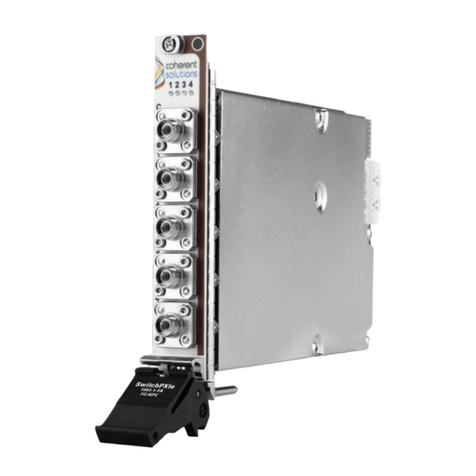
Coherent Solutions
Coherent Solutions SwitchPXIe 1000 Series user manual
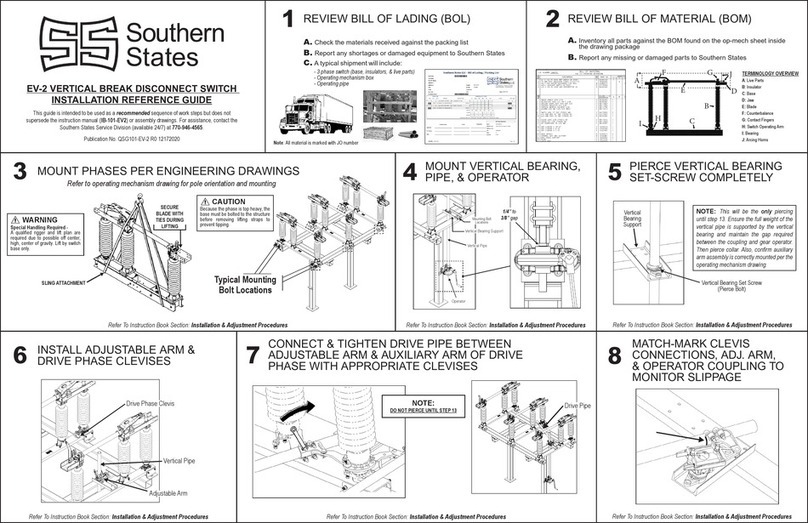
Southern States
Southern States EV-2 Installation reference guide

Splash
Splash Bootloader Domestic Installation

Hama
Hama USB 2.0 / Fire Wire Combo Operating instruction
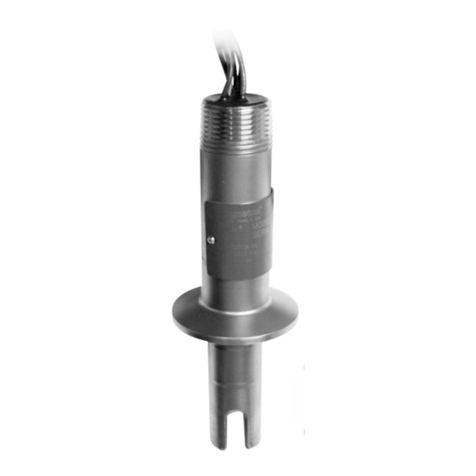
Magnetrol
Magnetrol ECHOTEL 940 Installation and operating manual
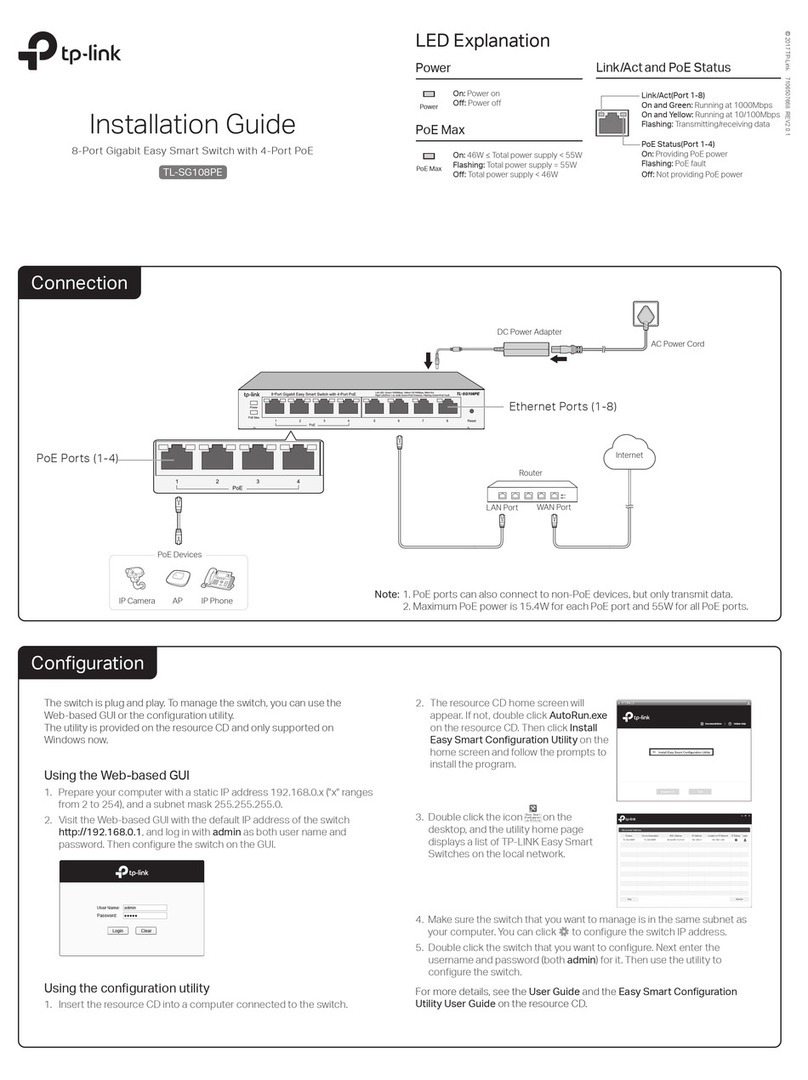
TP-Link
TP-Link TL-SG108PE installation guide
